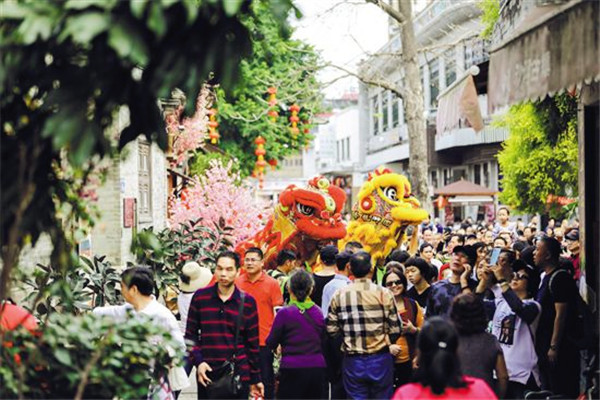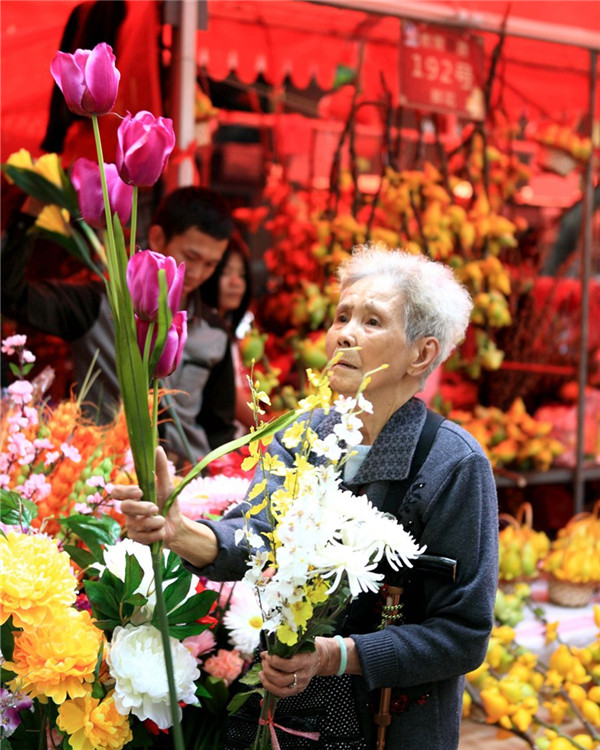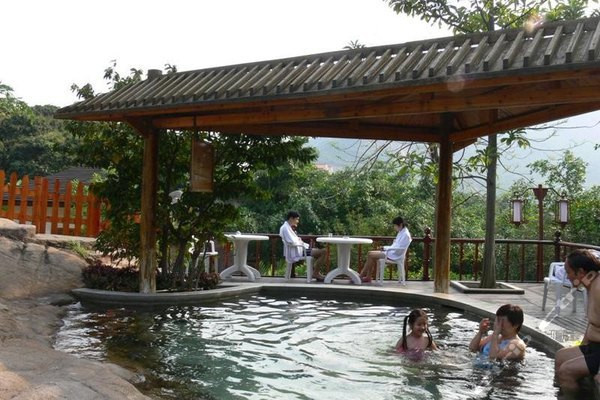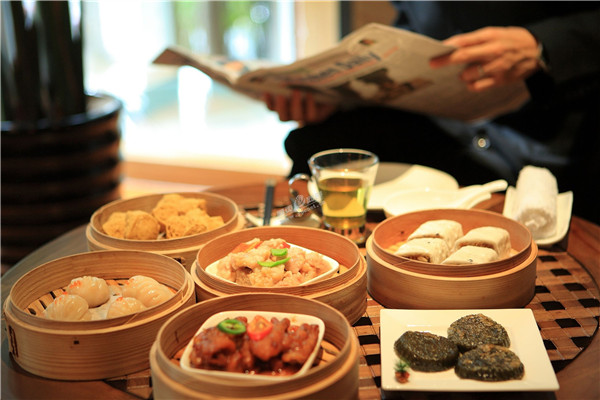Spend a splendid Spring Festival in Guangdong
Writer: Chen Xiaochun | Editor: Stephanie Yang | From: Shenzhen Daily | Updated: 2019-12-23
A+ A- Print
The “Welcome to Guangdong to Spend the Lunar New Year” promotional event was held in the city of Chongqing recently, presenting the warm, jubilant, festive atmosphere of the province, its diversity of cultures and its various Spring Festival offerings.
Every year, several million guests and friends come to Guangdong from all over the world for the Chinese New Year (also referred to as the Spring Festival). The unique festivities of the province include flower fairs, lantern shows, temple fairs, intangible cultural heritage activities, art exhibitions, grand variety shows, prayers for blessings, and other traditional and outdoor activities.
All these are made possible by Guangdong’s pleasant climate.
Guangdong is endowed with lush, verdant trees and vibrant, blooming flowers year-round. Tourists to anywhere in South Guangdong can wear skirts, go to a beach, take a bath in a hot spring and enjoy green scenery as part of their Spring Festival.
Enjoy traditional customs

Guangdong consists of three main cultures — namely the Cantonese, Hakka and Chaoshan cultures — each of which is rich in its own traditions and customs. Local customs are so varied they can even differ from village to village.
A temple fair is a typical local custom in Guangdong for the Spring Festival. In the capital city of Guangzhou, the renowned Canton Temple Fair is held from the 15th day to the 21st day of the first lunar month in Yuexiu District. It is carnivalesque, comprising a cultural parade, art shows and local delicacies.
Piaose is another traditional festival performance held during Nian Li, a unique traditional festival practiced in Guangdong, which presents children dressed up as characters from ancient Chinese mythological and historical stories. During Piaose, the child performers wearing the heavy makeup and special costumes stand or sit on iron shelving fixed on a special decorated, wheeled cart. The children sometimes perform gestures which help identify the figures they are representing.
The lion dance is a form of traditional Chinese dance performed throughout the year for joyous festivals, especially the Spring Festival, for good luck. It is one of the most important traditions of the Chinese New Year.
Recommended places:
Guangzhou: Guangdong Museum, Canton Temple Fair, Spring Festival garden tour at Nanhai God Temple
Foshan: Piaose performance, Ancient Nanfeng Kiln, Foshan Ancestral Temple, Chuanlord Tourism Leisure Expo Park
Huizhou: West Lake festive lantern fair, lighting event in Hexi Village of Longhua Town in Boluo County, village tour of Kuan Yin Temple in Zengguang Town
Zhaoqing: Dinghu Mountain, Longmu Imperial Ancestral Temple in Deqing, New Year market in Gulao Water Village, Kaiping Watchtowers
Maoming: Nian Li Festival, Gaozhou puppet show, the hometown of Lady Xian
Visit flower fairs

In Guangdong, you can find the first traces of spring at the Spring Festival flower fairs. Attending a flower fair during the Spring Festival is a long-standing tradition of Guangdong Province’s Lingnan area, which can be traced back to the Ming Dynasty (1368-1644) and consists of the lands south of the Nanling Mountains. Flowers, a necessity for Chinese New Year decorations, are regarded as the epitome of fortune, prosperity and blessings.
Each flower and fruit species has its own auspicious meaning. The peach blossom, for example, signifies romance and a happy marriage; tangerine trees are seen as auspicious (the pronunciation of “tangerine” sounds the same as “auspiciousness” in Cantonese); the butterfly orchid suggests future happiness.
Apart from flower booths, residents can also buy other Spring Festival decorations like Chinese couplets and Chinese handicrafts at the fair.
Recommended places:
Guangzhou: Lizhiwan Water Flower Fair, Tianhe District, Yuexiu Lantern Show, Chimelong Safari Park
Shenzhen: Shenzhen Spring Festival Flower Fair in the Futian CBD area, Overseas Chinese Town, Window of the World
Zhuhai: Xiangzhou Flower Fair, Chimelong International Ocean Tourist Resort
Zhongshan: Spring Festival Lantern Show, Zhan’s Garden, The Museum of Dr. Sun Yat-sen
Foshan: Chencun Flower World in Shunde, Xiqiao Mountain
Zhaoqing: Festooned vehicle parade, Seven-Star Cave, Plum Temple
Stroll along the coastline

Guangdong has the longest coastline on the Chinese mainland, measuring 4,114 kilometers in length. Endowed with vast sea views and over 1,400 islands, the province has the best seaside scenery to offer.
Jiaochangwei Village in Shenzhen may not be as famous as Yangmeikeng or Xichong, but it is the only village with a coastline in Dapeng New Area. There are many homesteads in the village built in various styles against fearsome seascapes. Most of the inns were rebuilt from vintage village houses. On a leisurely afternoon, cafés along the beach welcome visitors who wish to sit to simply feel the breeze and enjoy sunbathing.
With its seemingly countless islands, Zhuhai has earned itself the nickname of “city with 100 islands.” The renowned Lovers’ Road, a coastal road with a total length of 17 kilometers, encircles the coastline of the city like a silver ribbon.
Chuan Island of Jiangmen consists of two main islands, namely Shangchuan Island and Xiachuan Island, as well as 26 other small islands with dozens of natural coastal beaches and unique and fantastic views.
Hailing Island in Yangjiang City of Guangdong Province is one of the 10 most beautiful Chinese islands hailed by Chinese National Geography. In the southwest of Hailing Island lies a national 5A tourism area: Dajiao Bay.
Nan’ao Island is a break from downtown Shantou. It is good to visit the island on a warm winter’s day. The blue sky, white clouds, sounds of waves and seaside scenery make it a perfect place to linger.
Recommended places
Shenzhen: Dameisha Beach, Xiaomeisha Beach, Jiaochangwei Village
Zhuhai: Fishing Girl statue, Lovers’ Road, Chimelong International Ocean Tourist Resort
Jiangmen: Shangchuan Island, Xiachuan Island
Yangjiang: Hailing Island-Maritime Silk Road Museum of Guangdong
Zhanjiang: Dinglong Bay
Shanwei: Honghai Bay
Shantou: Nan’ao Island, Nan’ao Bridge
Dip in the hot springs

As Guangdong’s geography is abundant in geothermal resources, you’re never too far from one of the province’s hot springs. A visit to a hot spring is a uniquely Guangdong option for celebrating a family reunion or relaxing friends during the Spring Festival.
Wenquan Town in Guangzhou’s Conghua District, for example, is home to a great number of hot springs not too far from modern conveniences. One of them is at Guangdong Hot Spring Hotel, which is reputed as “the first hot spring in Lingnan.” Specifically, this is a sodium bicarbonate hot spring, making it a rock star of hot springs. Its unique healing effect on all sorts of ailments ranging from rheumatic arthritis, skin diseases, neurasthenia and the common cold makes it a favorite among the body-conscious.
Located in Xinhui District in Jiangmen, Gudou Hot Spring abounds in geothermal resources and is home to the rare combination of sodium chloride with radon in hot springs. This radon hot spring has been evaluated by experts to have the same water quality as the renowned ancient hot spring at Huaqing Pool in Shaanxi.
Located in the Sixth Patriarch’s Hometown Tourist Resort Area in Xinxing Town, Yunfu, Zen Hot Spring Resort sits right next to Guo’en Temple — China’s Holy Land of Zen Buddhism.
This “South China’s first hot spring” resort themed after Zen culture is invested by Guangdong Fenglu Aluminum Group with 1.2 billion yuan (US$178,920). Finely carved over decades, the resort has become a legendary piece of work.
Recommended places:
Guangzhou: Shimen National Forest Park, Wenquan Town
Jiangmen: Gudou Hot Spring, the Birds of Paradise
Yunfu: Guo’en Temple, Zen Hot Spring Resort
Qingyuan: Xinyinzhan Hot Spring Holiday Resort, Lianzhou Underground River, Nangang Thousand-Year Yao Village
Shaoguan: Danxia Mountain, Nanhua Temple, Jinglyulun Culture Tourist Town
Heyuan: Wanlyu Lake, Bavaria Manor
Savor delicacies

Guangdong cuisine (also known as “Yue cuisine”) tops the eight famous cuisines of China. Guangdong cuisine category alone covers more specific, localized specialties including Cantonese cuisine, Chaoshan cuisine, Hakka cuisine, and specialty seafood, all sure to tantalize your taste buds and make your mouth water at first sight.
Guangdong cuisine is considered the finest of China’s regional cuisines. An emphasis on preserving the natural flavors of the ingredients is its hallmark and a Guangdong chef would consider it a culinary sin of the highest order to produce a dish that was overcooked or too heavily seasoned.
Guangdong-style morning tea (zaocha) is not just tea, but a special breakfast that includes a smattering of small dishes. Having zaocha is a typical morning activity for Guangdong residents.
Nine-layer cake, originating from Chancheng District, is a renowned specialty of Foshan. The cake is made of rice and white sugar, and the nine layers symbolize longevity.
For many locals in Foshan, a bite of a bundled pig’s trotter stuffed with pork sold at Dexin Zhai may remind them of the good old days. The stuffed pig’s trotter is crispy outside and tender inside, gaining high praise from foodies from everywhere to be graced by it.
Yunwu tea and the tree it is derived from are native to Xiqiao Mountain. The Yunwu tea trees can be more than three meters in height with thick leaves and big sprouts. The shiny jet-black sprouts are the component used in the tea. Upon pouring hot water on the sprouts, the color will turn lighter and the taste bitter with a delicate fragrance. In spite of the immediate bitterness for the first try, the aftertaste is very refreshing.
Oyster omelette, as the name suggests, combines freshly shucked oyster meat with an eggy batter. There are several oyster omelet bases, but the simplest is a mixture of the egg batter, oyster meat, corn starch, coriander and seasonings, which is then fried in vegetable oil.
Leicha, or ground tea, is a traditional Hakka tea-based beverage. It is made of tea leaves, peanuts, rice, sesame seeds, beans, salt, orange peel and sometimes herbs. Hakka people usually use a mortar and pestle to make leicha.
Shantou’s beef hot pot is a household name around the country. If anyone (except a vegetarian) wants to be deeply impressed by the city, a meal of beef hot pot will do the trick. There are two main reasons why the beef hot pot is so delicious. First, the beef is fresh. Secondly, the chefs cut the meat in a specific way according to the textures of different parts of the cattle.
Recommended delicacies
Guangzhou: Zaocha (Guangdong style morning tea), wonton noodles
Foshan: Nine-layer cake, bundled pig’s trotter stuffed with pork sold at Dexin Zhai, yunwu tea of Xiqiao Mountain
Jieyang: Oyster omelette, leicha (ground tea)
Shantou: Beef meatballs, casserole porridge, beef hotpot
Chaozhou: Marinated meat, braised goose